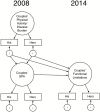Couples' Shared Beliefs About Aging and Implications for Future Functional Limitations
- PMID: 28854612
- PMCID: PMC5881752
- DOI: 10.1093/geront/gnx071
Couples' Shared Beliefs About Aging and Implications for Future Functional Limitations
Abstract
Purpose of the study: Individual beliefs are known to be predictive of health. This study examines the co-construction of couple norms and links couples' shared beliefs about aging to future individuals' and couples' functional limitations.
Design and methods: Data from the 2008 and 2014 waves of the Health and Retirement Study (1,231 couples; age range = 51-90) were analyzed using latent variables that estimated shared and individual variance in beliefs about aging in 2008 and functional limitations at follow-up in 2014. Spouses' individual processes of physical activity and disease burden were modeled to contribute to couples' shared beliefs about aging and subsequent functional limitations. Models progressively controlled for indicators of partner selection, couples' shared health experiences, and similarities and differences in age.
Results: Couples' beliefs about aging predicted future functional limitations. The effect magnitude decreased but remained significant in all models. Physical activity predicted couples' future functional limitations but was largely explained by shared health experiences and similarities and differences in age for wives and husbands, respectively. Disease burden contributed to couples' shared beliefs about aging. Husbands' contributions were explained by partner selection, but wives' contributions remained significant in all models. The effect of couples' shared beliefs on change in couples' functional limitations was explained by couples' shared health experiences.
Implications: Beliefs about aging and health occur within the context of close relationships and shared experiences. Knowledge of couples' beliefs and health is necessary to support their individual and collective efforts to age successfully together.
Keywords: Common fate model; Dyadic analysis; Health; Longitudinal analysis; Self-perceptions of aging.
© The Author 2017. Published by Oxford University Press on behalf of The Gerontological Society of America. All rights reserved. For permissions, please e-mail: journals.permissions@oup.com.
Figures

References
-
- Antonucci T. C., Fiori K. L., Birditt K. S., & Jackey L. M. H (2010). Convoys of social relations: Integrating life-span and life-course perspectives. In Lerner R. M. , Lamb M. E., & Freund A. M. (Eds.), The handbook of life-span development (Vol. 2, pp. 434–473). Hoboken, NJ: Wiley.
-
- Barrett A. E., & Montepare J. M (2015). “It’s about time”: Applying life span and life course perspectives to the study of subjective age. Annual Review of Gerontology and Geriatrics, 35, 55–77. doi:10.1891/0198-8794.35.55
-
- Brothers A., Miche M., Wahl H. W., & Diehl M (2015). Examination of associations among three distinct subjective aging constructs and their relevance for predicting developmental correlates. The Journals of Gerontology, Series B: Psychological Sciences and Social Sciences. doi:10.1093/geronb/gbv085 - PMC - PubMed
-
- Calasanti T. (2010). Gender relations and applied research on aging. Gerontologist, 50, 720–734. doi:10.1093/geront/gnq085 - PubMed
Publication types
MeSH terms
Grants and funding
LinkOut - more resources
Full Text Sources
Other Literature Sources
Medical
Research Materials

